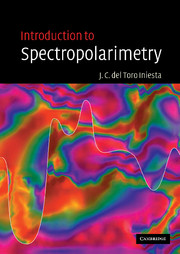Book contents
- Frontmatter
- Contents
- Preface
- Acknowledgements
- 1 Historical introduction
- 2 A review of some basic concepts
- 3 The polarization properties of quasi-monochromatic light
- 4 Linear optical systems acting on polarized light
- 5 Solar polarimetry
- 6 Absorption and dispersion
- 7 The radiative transfer equation
- 8 The RTE in the presence of a magnetic field
- 9 Solving the radiative transfer equation
- 10 Stokes spectrum diagnostics
- 11 Inversion of the RTE
- Index
11 - Inversion of the RTE
Published online by Cambridge University Press: 11 August 2009
- Frontmatter
- Contents
- Preface
- Acknowledgements
- 1 Historical introduction
- 2 A review of some basic concepts
- 3 The polarization properties of quasi-monochromatic light
- 4 Linear optical systems acting on polarized light
- 5 Solar polarimetry
- 6 Absorption and dispersion
- 7 The radiative transfer equation
- 8 The RTE in the presence of a magnetic field
- 9 Solving the radiative transfer equation
- 10 Stokes spectrum diagnostics
- 11 Inversion of the RTE
- Index
Summary
—“Would you tell me, please, which way I ought to go from here?”, said Alice. —“That depends a good deal on where you want to get to”, said the Cat. —“I don't much care where”, said Alice. —“Then it doesn't matter which way you go”, said the Cat.
—Lewis Carroll, 1865.Once one has a solution of the RTE, the most simple procedure of inference can be devised such that a comparison between calculated and observed Stokes spectra suggests modifications in prescribed models of the medium. Iteratively improved models refine the match between observations and theoretical calculations. When the match is good enough, the last model in the iteration is taken as a model of the medium and its characteristic parameters are the inferred parameters of the medium. This trial-and-error method may be useful when the model medium is very simple and contains just a few free parameters. Note that every change of a given free parameter implies an integration of the RTE which is a process requiring a great deal of computer time. If the number of free parameters is large, the manual trial-and-error method can become impracticable, but even automated trialand-error procedures that modify the various parameters randomly (blindly) may not converge to a physically reasonable final model of the medium. The results may even seem reasonable but be greatly in error.
- Type
- Chapter
- Information
- Introduction to Spectropolarimetry , pp. 199 - 219Publisher: Cambridge University PressPrint publication year: 2003



